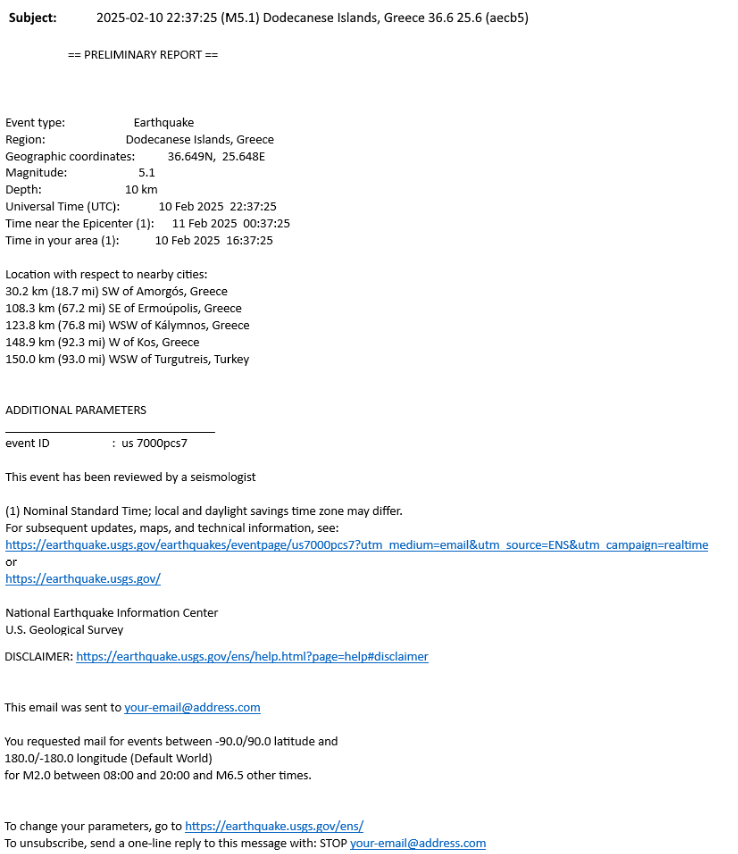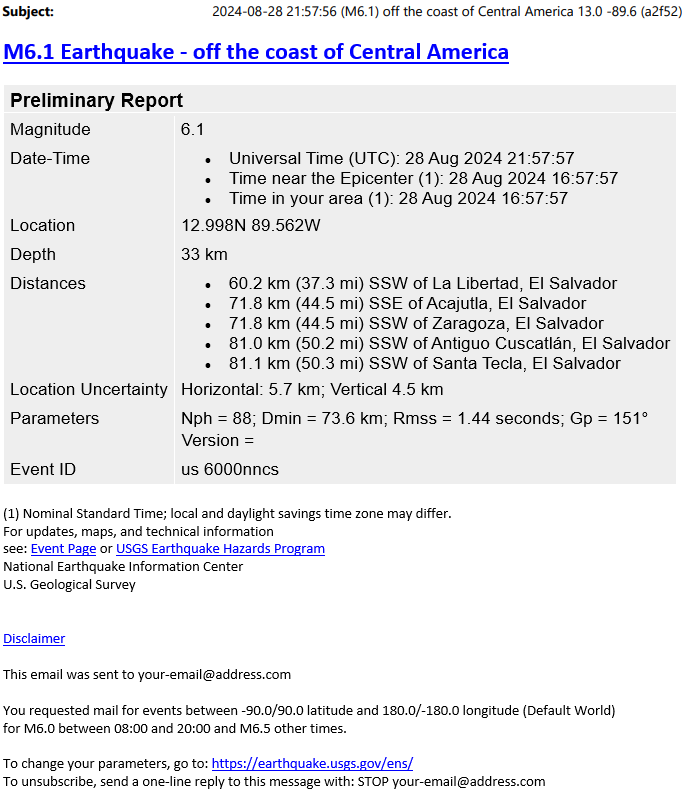ENS Glossary of Terms
Active
Use this to mark this region as active or inactive. This is useful for temporarily turning off email for vacations and such if you want to be able to reactivate it again without having to re-input the mail criteria. You will NOT receive any notifications that you missed after an Inactive account is set back to Active.
Address
Displayed are the email address(es) that are currently registered to your account. You may have up to 15 addresses associated with your account. To add a new address, use the 'Add New Email Address' button in the right column under the “My Email Addresses” section. This will prompt you for the address and what format messages you want to receive on it. It will then send you a confirmation message. Addresses are confirmed by sending you a random three-digit confirmation number to ensure that the address is working. Enter that number in the form provided. Addresses are not given or sold by the USGS to any outside organization. Note that for a new region, all addresses are selected by default. If there is an address you don't want associated with this region, then uncheck it. Privacy Policy
Affiliation
Please indicate your interest in earthquake notification.
Aftershock Exclusion
Large earthquakes generally will have many aftershocks. You may not wish to receive notification of all of them. This option will reduce the amount of mail you get after a large event. The ENS system will automatically define an aftershock zone and a magnitude threshold below which an earthquake will be considered an aftershock as follows: For events over M5.5 we will define an exclude region. The size of the aftershock zone is calculated according to the formula given by Wells and Coppersmith (1994).
The length is then multiplied by 2 and that number is used as the radius around the epicenter for the aftershock zone. We used a hexagon to approximate a circle. The magnitude limit is M-2 (2 units below the mainshock magnitude) within that region.
The length of time for the exclusion is based on the mainshock magnitude as follows…
- M5.5-M6.0: 10 days
- M6.0-M6.5: 20 days
- M6.5-M7.0: 30 days
- M7.0-M8.0: 60 days
- M8.0+: 120 days
This option can be turned on or off at any time on the “Account Preferences” tab.
Day Magnitude
This is your magnitude cutoff for daytime hours. You will be notified of any events greater than this magnitude during your specified daytime hours. See also Night Magnitude.
Day Begins/Day Ends
You need to specify hours to be considered 'daytime'. Times are based on a 24-hour clock. The 'end' value must be equal to or greater than the 'begin' value, and both must be in the range of 0-23 hours. If the day and night hours are equal, then all hours will be considered 'daytime' and you will get all notifications for events greater than your specified daytime magnitude. Note that the hours are specified in local standard time in your time zone that you specified when you opened your ENS account. If you need to change your time zone, use the 'Edit your account' function on the main page.
For an email account, start and end times of 00:00 are appropriate. Day and night hours are only really relevant for pagers or cellphones, where you might want to designate a night-time where you would receive fewer notifications.
Defer notifications during night hours
If a notification or an update occurs during your night hours that does not meet the magnitude threshold for nighttime, you will get the message at the start of the next day if you select “Yes”, and you will not get the notification or update if you select “No".
Event Depth
This option can be seen only if you indicate an affiliation of Scientist/Network Operator. Use this if you want to be notified about events in a certain area only within a certain depth range.
Language
Select your language. English and Spanish are currently the only choices.
Message Format
The message format is related to the type of account. The 'HTML' and 'long' formats are suitable for email, while the 'short' format is more appropriate for cell phones, pagers, and PDAs. The 'raw' format is a machine-readable compact format.
Example of Short Format:
M6.2 21:44 5/29 -30.2 -178.1 105km SSW of Raoul Island, Kermadec Islands US yra7 31b86
The information included is:
magnitude time (UTC) date latitude longitude descriptive location event_id email_id
Example of Long Format:

Example of HTML Format:

Most of the information is self-explanatory, but the information included in the PARAMETERS section is:
Nph - number of phases
Dmin - distance to nearest station
(km)
Rmss - rms misfit (seconds)
Gp - azimuthal gap (degrees)
M-type - magnitude type
Networks
You will only see these if you have indicated an affiliation of Scientist/Network Operator. These are the seismic networks to accept events from. You will only be notified of events declared by these networks. By default, all networks are selected (except AT, which provides preliminary solutions that are always superseded by NEIC or regional network locations within a few minutes). If you know that you want to exclude one or more, then uncheck them. Otherwise, leave them all checked. The choices are:
- CI: Southern California
- NC: Northern California
- NN: Nevada
- UU: Utah
- UW: Pacific Northwest
- AK: Alaska
- NM: New Madrid - University of Memphis
- HV: Hawaii Volcano Observatory
- PR: Puerto Rico Seismic Network
- US: NEIC worldwide network
- SE: Southeastern U.S.
- WY: Yellowstone Seismic Network - Wyoming
- AR: Arizona Seismic Network
- AT: Alaska Tsunami Warning Center
- TX: Texas Seismological Network
Night Magnitude
This is your magnitude cutoff for non-daytime hours. You will be notified of any events greater than this magnitude during these hours. Typically your night magnitude will be larger than your day magnitude so that you're less likely to get notifications while you're sleeping, but there is no reason why night can't be the same as the daytime setting. It all depends on your personal schedule and when you want to receive alerts. This is only really applicable if you are having alerts sent to a pager or cell phone that can wake you up in the middle of the night. If you are having alerts sent to an email account that won't wake you up in the middle of the night, then you will probably want the night magnitude to be the same as the day magnitude. You will NOT receive any notifications that you missed after the Night Magnitude time period is over and the Day Magnitude period begins. See also Day Magnitude.
Region Name
This is an optional field where you can enter a name for your region. The name is used to identify the region on your account display, and also in the footer of any messages sent to you.
Time Zone
Select your time zone, based on your offset from GMT. For areas where daylight saving time is implemented, select your time zone based on the offset for Standard Time. What's my time zone?
Updates and deletions for events
Updates are sent for previous notifications if the magnitude changes by more than 0.4 or the location changes by more than 0.5 degrees of latitude or longitude. Deletion messages are sent if the system previously sent a notification for a nonexistent event. If you do not want to receive any updates or deletions, select “No”.

